Anger, fear, rage- these are the last three things you want your pet to feel. Fear aggression in dogs stems from these emotions.
We never want to inflict hardship on our pets, but there are things beyond our control. Your fur baby must face the big world out there one way or another. Therefore, you must learn to calm fear aggression in dogs to keep your dog and other dogs safe.
Now, you may wonder- how do you know if your dog has fear aggression?
Before we tackle how to calm fear aggression in dogs, we must learn to spot the symptoms in the first place.
Signs of Fear Aggression in Dogs
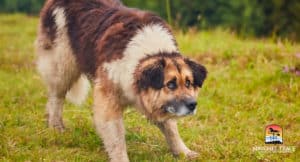 Aggression comes from varying emotions such as dominance, insecurity, or extreme fear. The reactions may seem similar to the untrained eye, but fear aggression in dogs can be differentiated into subtypes.
Aggression comes from varying emotions such as dominance, insecurity, or extreme fear. The reactions may seem similar to the untrained eye, but fear aggression in dogs can be differentiated into subtypes.
If your dog feels fear, he usually:
-
- Becomes timid with his tail tucked under
-
- Cowers with his head lower than his back
-
- Pins his ears back
-
- Trembles, growls, and/or snarls
-
- Shows the whites of his eyes
-
- Shows tension in his lips
The more a dog remains in that phase, the more his fear aggression escalates. Worse circumstances may cause him to additionally:
-
- Pant with his mouth open and teeth bare
-
- Begin making louder and more excessive vocalizations
-
- Snap his jaws together
-
- Resort to biting
Fearful dogs usually run away from the source of their fear. Finding your pets in aggressive situations usually means they have nowhere else to go. They will fight only when they cannot take flight.
The sight of fear aggression in dogs is painful to a pet parent. While others may see it as misbehavior, you must understand that there are reasons why it exists in the first place.
Reasons for Fear Aggression in Dogs
 Reasons for fear aggression in dogs are called triggers. There may be only one, or a combination of a few triggers.
Reasons for fear aggression in dogs are called triggers. There may be only one, or a combination of a few triggers.
Fear aggression in dogs either occurs gradually or after a sudden change or event that your pet can’t handle. Some factors that lead to fear aggression in dogs are:
-
- Poor socialization. Poor socialization can cause fear aggression in dogs. A puppy’s developmental stage can make or break his social skills. Being left alone or untrained during development can lead dogs to be more fearful as they age.
-
- Unfamiliar interactions. Although dogs are naturally playful, not everyone enjoys meeting strangers. Even in the comfort of your home, welcoming a guest can be a problem if your dog is afraid of unfamiliar interactions. You can only wait for your pet to approach strangers on his own terms, not theirs and neither yours.
-
- Violent environment/s. When stray, free roaming, neglected or abused dogs are left to fend for themselves alone in violent environments, they can become fearful. Any cruelty they endure often forces them to become more defensive than accepting.
-
- Feeling Trapped or Cornered. A living being’s automatic response when scared is to run away – as far as possible. Dogs are especially good at escaping. Only when they feel trapped or cornered do they get the urge to fight.
-
- Restrictions or Overcrowding. Because fear aggression in dogs is due to feeling trapped, it is unwise to bring them to overcrowded places. Crowds may lead to extra restraint by their handler (and less ability for a dog to defend himself), which can lead to rage if provoked.
-
- Traumatic Experiences. Adopting dogs is an act of saving them, but ignorance of their history will require more patience when they deal with traumatic experiences. That is not to say these will not happen when you dote on your dog since birth. Traumatic events come in many forms such as abuse, loss, and even when a child just happens to accidentally poke your dog’s eye.
-
- Physical Disorders. Sickness is a sign of weakness in dogs. Chronic diseases or losing sight, hearing, or other senses will make a dog more sensitive to his surroundings. As such, he puts his guard up higher. At the slightest sense of danger, you will find his hackles rising.
-
- Startling movements and/or sounds. A fearful dog is always on edge. Unpredictable movements and loud sounds will make things worse for him. Hence, it is not always advisable to let an anxious dog live in a house with young children or other animals.
An experienced veterinarian can easily help you determine which of these factors is triggering fear aggression in your dog.
Once you know where their fear springs from, you can take better steps to alleviate it.
5 Realistic Steps You Can Take to Calm Fear Aggression in Dogs
Fear aggression in dogs does not equal a bad pet. Like how some humans become aggressive in uncomfortable situations, a dog may resort to a defensive stance when left with no other choice. This is normal, and it benefits your dog if you understand where he is coming from.
With this consideration in mind, here are five realistic steps you can take to help calm fear aggression in dogs:
-
Observation
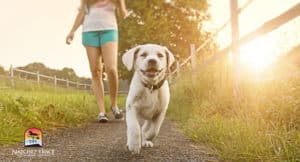 This may sound simple, but finding out what scares your distressed dog will take effort and time. You must familiarize yourself with your pet’s tendencies and behavior so you can better understand his triggers.
This may sound simple, but finding out what scares your distressed dog will take effort and time. You must familiarize yourself with your pet’s tendencies and behavior so you can better understand his triggers.
Keep a note within reach or on your phone. Write down anything you find unusual or questionable. Once you know what situations cause fear to your pet, you can take precautions in dealing with them. Ask a vet if you don’t know how.Triggers can range from feeling trapped, meeting dominant figures, hearing gunshots, seeing playful children, or experiencing traumatic associations with certain types of smell, taste, or sound. The triggers are different for each dog, so remain vigilant and focused.
To illustrate, you notice that opening his kennel when he’s asleep startles him. Write this down. Now that you know, the next time you let him out, you can try opening the door and backing away so he won’t feel cornered.
The worst scars are the hidden ones. You can only heal them if you know where to look.
-
Training
 Training fear aggression in dogs will require a lot of your time and more than enough patience. You can do it on your own but depending on the severity, it is best to ask for help from a professional dog trainer.
Training fear aggression in dogs will require a lot of your time and more than enough patience. You can do it on your own but depending on the severity, it is best to ask for help from a professional dog trainer.Obedience training is a perfect strategy to address aggressive behaviors. It can help your pet gain the confidence needed to stop acting aggressively, especially when confronted with fear. Throughout the training, you must remain calm but assertive so your dog will learn to ultimately trust you rather than reacting to triggers.
Once trained, your canine companion will rely on you to command him toward his safety during alarming conditions.
On a side note, start training your puppy as early as 7-8 weeks old to develop social skills. He can then avoid developing fear and aggressive behaviors as much as possible.
-
Exposure
 Facing your fears is never an easy thing to do. One at a time, in a controlled environment, slowly expose your dog to his fears. The best way to combat terror is to overcome it, so help your pet get through it all.
Facing your fears is never an easy thing to do. One at a time, in a controlled environment, slowly expose your dog to his fears. The best way to combat terror is to overcome it, so help your pet get through it all.
The correct exposure to calm fear aggression in dogs is to start little by little and then gradually go big.For example, if your dog is triggered by certain sounds, start with a soft level. Slowly up the volume until it gets to a natural stage. If he fears being leashed, let him see the collar from a distance. Bring it closer, show that it is harmless, and let him get familiar with it.
Reward your pet every single time he makes the right choice, no matter how small the act may seem. On the other hand, do not punish him if he can’t take that leap of faith. It takes time to be brave.
-
Treatment
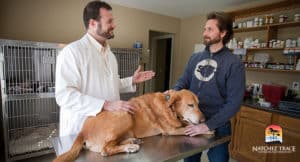 Animals do not want to exhibit vulnerability. If your easygoing and friendly dog suddenly lashes out in fear, underlying health conditions may have forced him to be neurotic. Have a vet examine him in case he is hiding some kind of disease. Getting treatment will return him to a state of joyful confidence.
Animals do not want to exhibit vulnerability. If your easygoing and friendly dog suddenly lashes out in fear, underlying health conditions may have forced him to be neurotic. Have a vet examine him in case he is hiding some kind of disease. Getting treatment will return him to a state of joyful confidence. -
Medication
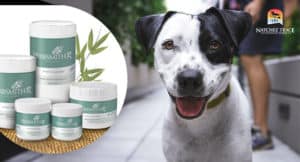 Dogs get anxious just like humans do. Fortunately, we live in an age when years of animal research have addressed and are continuously addressing this problem.
Dogs get anxious just like humans do. Fortunately, we live in an age when years of animal research have addressed and are continuously addressing this problem.
Herbal formulas like Herbsmith Rx Peony Calm Shen are made of natural ingredients and work well with anxious and disturbed animals. You can ask your vet for an authorization.
Always contact a veterinarian before starting your dog on any supplement. It is crucial for his safety and your peace of mind that the ingredients and effects of certain herbs will work with his constitution.
As you continue to calm fear aggression in your dog, you must always remain collected and composed. You need to become your dog’s safe space. Be someone he can rely on to stay calm even in the most chaotic and fearful times.
As a pet parent, your doubt, stress, and anxiety will only cause your dog to hesitate, panic, and get frightened.
At all times, provide your dog with a safe place that he can run into when he is afraid. This can be his own doghouse in the backyard, corner in the living room, or the space between your feet when you go out for walks or training sessions.
Inform other people when going through the process of dealing with your dog’s fears. Even strangers and children with good intentions are not safe. Be firm with the rules, otherwise, your pet won’t know how to trust you.
Never punish your dogs for acting out on their fear. It will only make things worse. He is already afraid of other things. Don’t give him a reason to fear you too.
Be gentle as you continue to observe, train, expose, and balance your dog to calm his fear aggression.
Herbsmith Peony Calm Shen
 Anxiety is the most basic root of fear aggression in dogs. Anxiety symptoms are how the mind and body react to negative emotions that come with stress, disturbance, irritability, confusion, and dread.
Anxiety is the most basic root of fear aggression in dogs. Anxiety symptoms are how the mind and body react to negative emotions that come with stress, disturbance, irritability, confusion, and dread.
Herbsmith Peony Calm Shen is an Eastern herbal formula that lives up to its name and truly works to calm fear aggression in dogs.
Traditional Chinese Veterinary Medicine (TCVM) veterinarians believe in healing animals as a whole and not just the part where it hurts. Peony Calm Shen addresses the overall health and balance of dogs to calm them down. Its ingredients are:
-
- Bai Shao Yao / White Peony Root
-
- Bai Zi Ren / Bupleurum Root
-
- Dan Shen / Salvia Root
-
- Dan Gui Tou / Angelica Sinensis
-
- Fu Shen / Poria
-
- Mai Men Dong / Ophiopogon Tuber
-
- Qing Pi / Tangerine Peel
-
- Suan Zao Ren / Zizyphus
-
- Jujube Seed (suan zao ren)
-
- Tian Men Dong / Asparagus Tuber
-
- Wu Wei Zi / Schisandra Fruit
-
- Xiang Fu Zi / Nut Grass Rhizome – Cyperus
-
- Xuan Shen / Scrophularia Root
-
- Ye Jiao Teng / Polygonum Multiflorum Vine
-
- Yuan Zhi / Polygala Root
This combination of natural plants, herbs, and roots all work together to heal the liver, heart, and blood flow of your pet. Once the liver is soothed, the toxins flushed, the heart calmed, and the blood nourished, your fur baby will begin to feel more relaxed.
Remember!
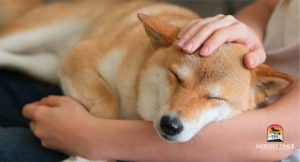 You made a lifetime commitment when you got your pet, and he doesn’t want to disappoint you. Once your dog feels the need to turn aggressive when afraid, there is no going back. You have to be determined, patient, and loyal to earn his complete trust.
You made a lifetime commitment when you got your pet, and he doesn’t want to disappoint you. Once your dog feels the need to turn aggressive when afraid, there is no going back. You have to be determined, patient, and loyal to earn his complete trust.
Be quick to realize if his hostility comes from fear, then figure out what caused it, so you can manage to calm him down. This will take time, but creating lasting relationships with pets is worth it.
Always seek the advice of Dr. Smith with any questions regarding how to calm fear aggression in dogs.








